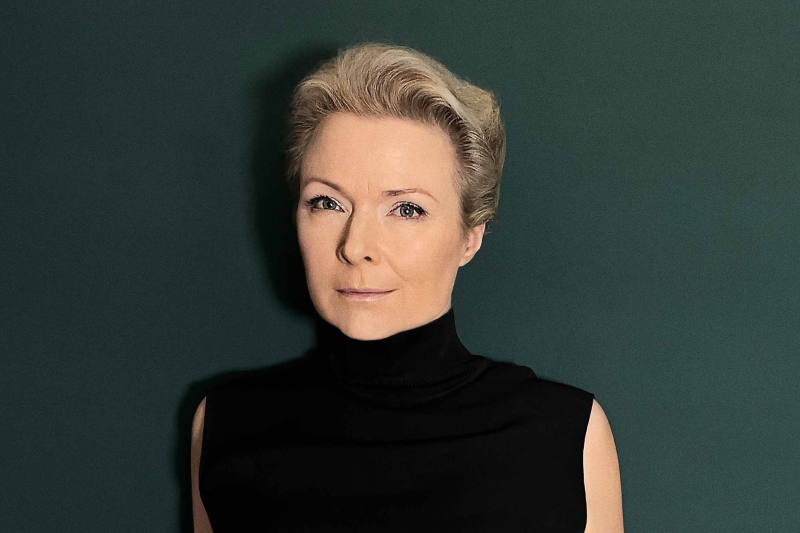Helle Helle

Helle Helle
Rationale:
Helle Helle’s body of work continues to expand and be fluid. Into buses, up steps, out into the forest, across fields, on top of petrol stations. In Hafni fortæller (in English: “Hafni Says”) she sets out in a new direction. In this novel, Helle Helle takes us on a smörgåsbord of a journey through Denmark.
Hafni fortæller is a radically experimental and completely unbridled book. It’s a novel about crisis and downfall, about the will to live, alienation, freedom, guilt and shame, and the heavy gaze of expectation. Simply put, it’s a novel about existence. With sports socks tightly pulled up around her calves, Hafni is constantly on the verge of action.
The 48-year-old is getting divorced. This turning point sends her on a long-desired road trip. She has decided that now is a good time to taste her way through Danish lunchtime cuisine: “Shooting Star”, “Herring Eye”, and the like. Wiener schnitzel with anchovies, capers, and horseradish – “with a boy on it” as they say in Danish. “I don’t want a boy on my meat,” says Hafni in one of many beautifully absurd turns of phrase in the book. Like no other, Helle Helle points out cultural oddities that embed themselves as linguistic conventions, which one can easily let flow straight through one’s mouth without tasting them. Helle Helle makes us think not just about language, but about using it.
Although the novel may be about Hafni, it also belongs to the language. The path to storytelling goes via the sentence. With Helle Helle, it’s the language that determines the direction. “It’s allowed to choose a route because of a place name,” it says. And perhaps that’s why the story must pass through the town of Pøl (puddle) on the island of Als. Because Hafni has been to hell and back, – she finds herself in a mud puddle. She falls, sinks, and topples down into a deep darkness. The language thickens, only giving us the most essential, like here: “Then arms and legs went out, and the raised eyebrows didn’t bring the eyelids along with them.”
Even the humour is dark to the point of pitch black. And in the laughter, the light breaks through. Overall, the novel grows and expands, becoming broader and wilder, such as when she occasionally breaks the narrative with some hard-hitting, square pieces of text. They contain memory flashes, states, build-ups of household advice – everything we carry with us. They rise above the narrative as pure poetry, modernistic in their approach. Or like when unable to sleep one night, Hafni offers an elderly gentleman a gold caramel that goes straight through his hand. Are we talking about a ghost here? The novel certainly raises questions about how we are visible to ourselves and to others. Perhaps it’s easiest to mimic others, to smile someone else’s smile, as it reads in the book. For Hafni, it’s true that the shadows of thought loom over her and her ability to act. The expectations she has of herself and her expectations of others’ expectations. Again and again, she finds herself falling into a yes when she might rather have leaned towards a no. If someone tells her that a hand soap with tutti-frutti scent is on sale, she buys it. If she walks into an art gallery, she comes out with a blue watercolour with crabs. If someone proposes to her outside the Imperial cinema, she gets married.
The longing for and fear of navigating the human realm puts her in awkward, painfully comedic situations. For example, standing in line at the supermarket and continuing to stand in it, just to feel a form of closeness. Or sitting alone at a campsite as darkness falls and saying, “The two of us”, when an insect lands on the table. Or feeling freer towards things than towards people.
The novel is filled with wonderful double entendres, friction, and subtext. On the one hand, there’s self-erasure with all its negations (not doing this, not doing that), which makes Hafni apologise for saying sorry. On the other hand, a form of defiance: “Her silence is a ghost in empty spaces. But she wants no empty spaces.” And the book confirms it. Hafni stands upright. She speaks. And while Hafni may be preoccupied with norms (although she doesn’t like the word “normative”), Helle Helle isn’t afraid to break the unwritten rules of style. Who else would start their novel with a subordinate clause? And who else would title the novel Hafni Says (as it translates in English), but not let Hafni be the narrator of it? Who else would let the novel unfold like a phone conversation, where only one person speaks, while the many perspectives provide the novel with a polyphony? Who else can effortlessly move between time and narrative planes and make their reader laugh out loud at the use of “He said”, “She says”? Who else tells their story to an unnamed person, whom you understand you’ve met before in the novels de and BOB, so that in this way an authorship becomes a sort of living organism, a conversation where the works complement and catch up with each other? These are rhetorical questions. Stylistically, there’s no holding back, and no one can hold Helle Helle back.
In the course of life, you get rounder arms, and perhaps you realise that life moves in circles and not in linear progressions. At least Hafni fortæller doesn’t. It doesn’t indicate a direction. It simply tries to be.
Helle Helle has long proven that her authorship can’t be dismissed in a subordinate clause. Several of her novels already stand as masterpieces in Danish literature. Hafni fortæller is no exception.